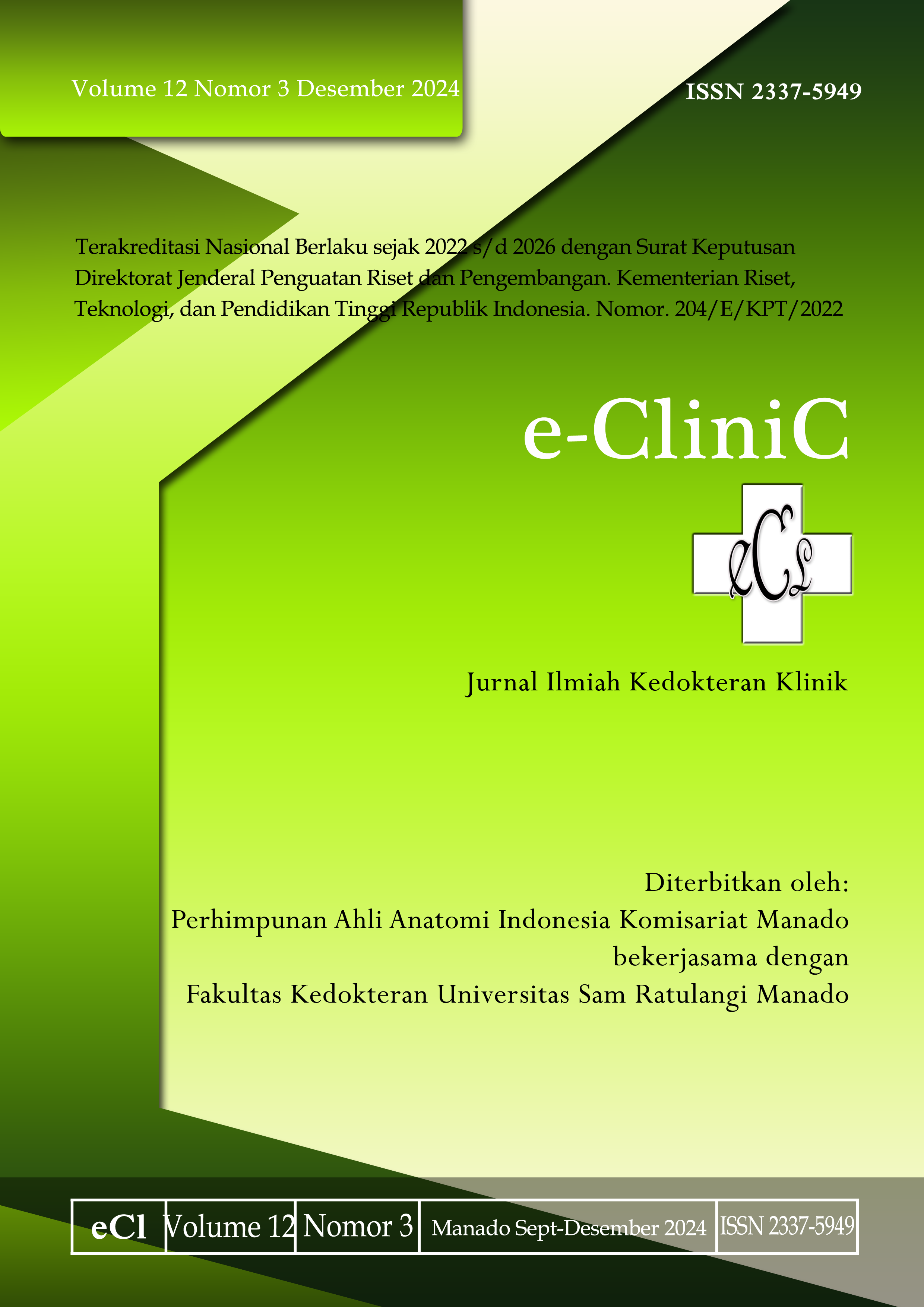Identifikasi Pola Bakteri dan Uji Sensitivitas Antibiotik di Ruangan Instalasi Gawat Darurat RSU GMIM Pancaran Kasih Manado
DOI:
https://doi.org/10.35790/ecl.v12i3.54050Abstract
Abstract: Incidents of infection originating from hospitals can be referred to as Healthcare-Associated Infections (HAIs). Generally, hospitals have implemented policies and clinical practices in control of HAIs and the appropriate use of antibiotics to reduce the risk of infection spread and the development of antibiotic resistance. However, antibiotic administration in the Emergency Room (ER) significantly contributes to the excessive use of antibiotics, which may pose a problem of antibiotic resistance. This study aieds to determine the bacterial pattern and antibiotic sensitivity in the ER of RSU GMIM Pancaran Kasih Manado. This was an observational and descriptive study with a cross-sectional design. Identification of bacterial pattern and antibiotic sensitivity test on bacteria in the ER of RSU GMIM Pancaran Kasih Manado used the standard procedure in Microbiology Laboratory of Faculty of Medicine, Universitas Sam Ratulangi. The antibiotic sensitivity test for Bacillus sp. (53.84%), Staphylococcus sp. (38,46%), and Streptococcus sp. (7,69%) revealed the highest sensitivity to the antibiotics meropenem and gentamicin, while the antibiotics ampicillin/sulbactam and vancomycin showed the highest resistance levels. In conclusion, Gram-positive bacteria dominates the bacteria in the emerfency room of RSU GMIM Pancaran Kasih Manado, with Bacillus sp. being the most prevalent.
Keywords: bacterial pattern; antibiotic sensitivity test; emergency room
Abstrak: Kejadian infeksi yang berasal dari rumah sakit termasuk dalam Healthcare-Associated Infections (HAIs). Rumah sakit telah menerapkan kebijakan dan praktik klinis dalam pengendalian HAIs dan penggunaan antibiotik yang tepat untuk mengurangi risiko penyebaran infeksi dan perkembangan resistansi antibiotik. Namun, ditemukan bahwa pemberian antibiotik di Instalasi Gawat Darurat (IGD) secara signifikan berkontribusi terhadap penggunaan berlebihan dari obat antibiotik yang kemungkinan menimbulkan masalah resistansi. Penelitian ini bertujuan untuk mengidentifikasi pola bakteri dan sensitivitas antibiotik di ruangan IGD RSU GMIM Pancaran Kasih Manado. Jenis penelitian ialah deskriptif observational dengan desain potong lintang. Identifikasi pola bakteri dan uji sensitivitas pada bakteri di ruangan IGD RSU GMIM Pancaran Kasih Manado menggunakan prosedur standar di Laboratorium FK Unsrat. Hasil identifikasi diperoleh bakteri Bacillus sp., Staphylococcus sp., dan Streptococcus sp. Uji sensitivitas antibiotik dari bakteri Bacillus sp. (53,84%), Staphylococcus sp. (38,46%), serta Streptococcus sp. (7,69%), mendapatkan tingkat sensitivitas tertinggi ditunjukkan terhadap antibiotik meropenem dan gentamicin, sedangkan hasil antibiotik ampicillin/sulbactam dan vancomycin memiliki tingkat resistensi tertinggi. Simpulan penelitian ini ialah bakteri Gram positif mendominasi bakteri di ruangan IGD RSU GMIM Pancaran Kasih Manado, dengan ditemukannya Bacillus sp. terbanyak.
Kata kunci: pola bakteri; uji sensitivitas antibiotik; Instalasi Gawat Darurat
References
Kemenkes RI. Permenkes No 3 Tahun 2020 Tentang Klasifikasi dan Perizinan Rumah Sakit. Tentang Klasifikasi Dan Perizinan Rumah Sakit. 2020;(3):1–80. Available from: http://bppsdmk.kemkes.go.id/web/filesa/ peraturan/119.pdf
Putri T, Waworuntu O, Rares F. Pola bakteri aerob yang berpotensi menyebabkan infeksi nosokomial di Ruang Instalasi Bedah Sentral (IBS) RSUP Prof. Dr. R.D. Kandou Manado. eBiomedik. 2019;7(1):14-8. Doi: https://doi.org/10.35790/ebm.v7i1.22450
Rahmawati SA, Dhamanti I. Infection Prevention and Control (IPC) program in hospital. Journal of Health Science and Prevention. 2021;5(1):23-32. Doi: https://doi.org/10.29080/jhsp.v5i1.396
Gobel SN, Rares FE, Homenta H. Pola bakteri aerob yang berpotensi menyebabkan infeksi nosokomial di Instalasi Gawat Darurat RSAD Robert Wolter Mongisidi Manado. eBiomedik. 2016;4(2). Doi: https://doi.org/10.35790/ebm.v4i2.14608
Maki G, Zervos M. Health care–acquired infections in low- and middle income countries and the role of infection prevention and control. Infect Dis Clin North Am. 2021;35(3):827-39. Doi: 10.1016/j.idc.2021.04.014.
Mudrika, Misnarliah. Pola pertumbuhan dan sensitivitas antibiotik bakteri penyebab infeksi nosokomial di Ruang Intensive Care Unit (ICU). Nursing Arts. 2022;16(2). Doi: 10.33476/jky.v20i3.168
Kartika RA, Setiawati MCN, Prasetyaningrum E. Penggunaan antibiotik pada pasien BPJS di IGD RSUD dr. Gondo Suwarno Kabupaten Semarang. Jurnal Ilmu Farmasi dan Farmasi Klinik (JIFFK). 2022;19(1):1-7. Available from L https://publikasiilmiah.unwahas.ac.id/index.php/Farmasi/article/view/6677
Medicinenet. Staph (Staphylococcus) Infection. 2023 [cited 2023 Nov 24]. Available from: https://www.medicinenet.com/staph_infection/article.htm
Baharutan A, Rares FES, Soelingan S. Pola bakteri penyebab infeksi nosokomial pada ruang perawatan intensif anak di BLU RSUP Prof. Dr. R. D. Kandou Manado eBiomedik. 2015;3(1):412-9. Doi: https://doi.org/10.35790/ebm.v3i1.7417
Medicinenet. What is a Streptococcal Infection? 2023 [cited 2023 Nov 24]. Available from: https://www.medicinenet.com/streptococcal_infection/article.htm
Ferryansyah, Endriani R, Wahid TOR. Pola bakteri dan sensitivitas antibiotik di kamar operasi bedah di Instalasi Bedah Sentral RSUD Arifin Achmad Pekanbaru. Jurnal Ilmu Kedokteran (JIK). 2009;3(2). Available from: https://jik.ejournal.unri.ac.id/index.php/JIK/article/view/3758/3661
Hidayat, Izzuddin A, Santibudi S, Novpriani S. Perbandingan pola sensitivitas bakteri terhadap antibiotik di ruang ICU dan Ruang Rawat Inap Non-ICU di Rumah Sakit Umum Daerah Dr. H. Abdul Moeloek Bandar Lampung. Jurnal Ilmu Kedokteran dan Kesehatan. 2021;8(1):56-65. Doi: https://doi.org/ 10.33024/jikk.v8i1.3939
Tolera M, Abate D, Dheresa M, Marami D. Bacterial nosocomial infections and antimicrobial susceptibility pattern among patients admitted at Hiwot Fana Specialized University Hospital, Eastern Ethiopia. Adv Med. 2018:2127814. Doi: 10.1155/2018/2127814
Downloads
Published
How to Cite
Issue
Section
License
Copyright (c) 2024 Sulaiman F. Sandjaya, Olivia A. Waworuntu, Heriyannis Homenta

This work is licensed under a Creative Commons Attribution-NonCommercial 4.0 International License.
COPYRIGHT
Authors who publish with this journal agree to the following terms:
Authors hold their copyright and grant this journal the privilege of first publication, with the work simultaneously licensed under a Creative Commons Attribution License that permits others to impart the work with an acknowledgment of the work's origin and initial publication by this journal.
Authors can enter into separate or additional contractual arrangements for the non-exclusive distribution of the journal's published version of the work (for example, post it to an institutional repository or publish it in a book), with an acknowledgment of its underlying publication in this journal.
Authors are permitted and encouraged to post their work online (for example, in institutional repositories or on their website) as it can lead to productive exchanges, as well as earlier and greater citation of the published work (See The Effect of Open Access).







